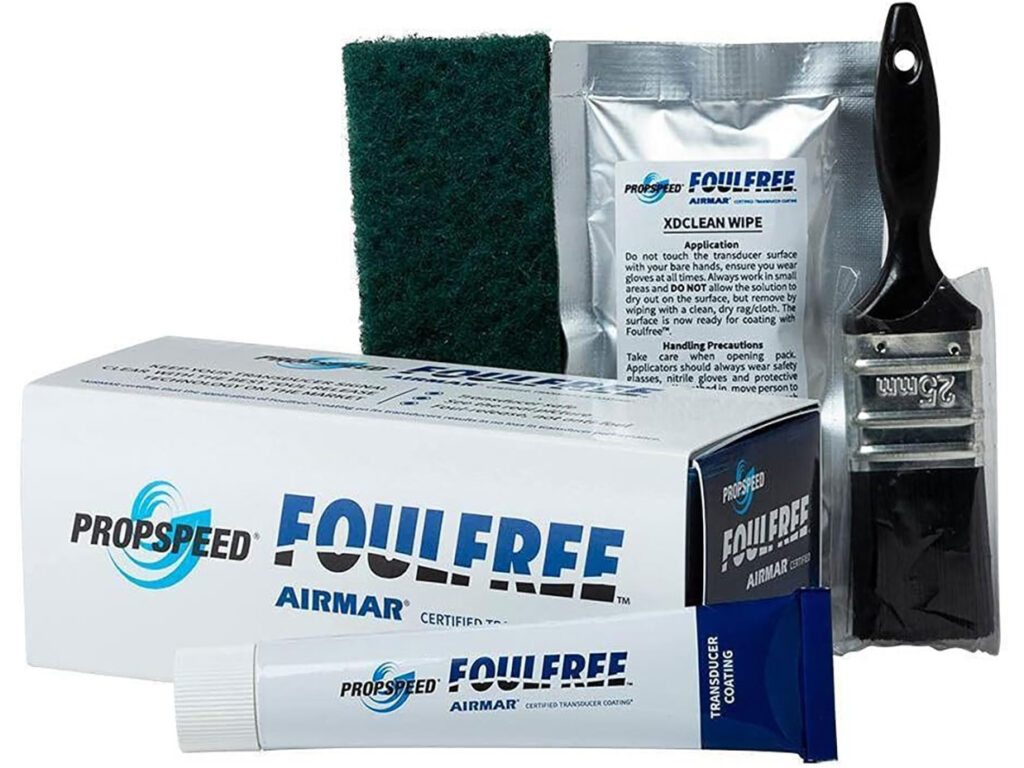
I’ve always applied antifouling paint to the transducers installed on my Regulator, Breakaway. Doing so ensures the output and return signals deliver better performance instead of being reduced by barnacles, grass or other growth on the ‘ducer. Twice, I’ve neglected to coat a transducer, I regretted it, as performance waned. Typically, I have used the same aerosol antifouling coating that I use to protect my outboard’s mounting bracket and my trim tabs. This worked fine.
Last year, I applied Foulfree by Propspeed to a new transducer I was installing aboard Breakaway. Foulfree is a foul-release, as opposed to anti-fouling coating. It contains no toxic biocides. Instead, it creates a surface so slippery that critters and plants get washed off as the boat is underway. This same technology has been successfully applied with Propspeed’s Propspeed coating, for propellers. In any event, a biocide-free coating sounds like a good idea to me. If it would provide solid protection.
To test Foulfree, I applied it to the one transducer. For comparison, I applied Interlux Trilux 33 aerosol to other transducers on the boat. The boat was then launched and stored in the water for six months in the Northeast United States. At haul out, in the fall, both transducers were equally clean.
The difference? Foulfree required additional prep and effort versus the Trilux. Of course, Foulfree contains no poisonous biocides. Points for the environment and personal safety in application. Additionally, Foulfree is certified by Airmar, world renown maker of transducers for most major brands of depth and fishfinders, to not impair transducer performance. I do not know if the Trilux 33 affected my transducer’s performance, though I have been historically-satisfied with transducer performance using that coating, or one like it.
Propspeed Foulfree comes in a kit that includes everything you need to cover about 1 square foot of transducer surface. That translates to coverage for between two and maybe four transducers. $35.99, freeportmarine.com.
Applying Foulfree
Applying Foulfree takes three basic steps. Clean the surface, prep the surface, apply Foulfree. Most of what you need is in the kit. You will need to supply some gear of your own:
- Disposable gloves
- Eye protection
- Mask
- Clean, dry rag
- Tape
- Fairing blocks only – 40 grit sandpaper (This means DO NOT sand the transducer face! Only sand plastic fairing blocks on through-hull transducers!)
For Existing Transducers
I applied Foulfree to a new transducer. If you are applying to a transducer with growth or dirt on it, follow these steps, reprinted from Foulfree, which is what I did.
Remove fouling and/or any previous coatings from the transducer housing and face with the abrasive pad provided.
In case of heavy fouling, scrape transducer face with a metal putty knife without gouging the surface. Drag the putty knife across the transducer face at a perpendicular angle and follow with a wet sanding block. Never use a power sander or pressure washer on the face of the transducer.
Take care not to scratch or damage the transducer face.
Read Next: Mounting an In-Hull Transducer on a Boat
New or Clean Transducers
1. Abrasive Pad
Firstly, lightly scuff/abrade plastic housing and face of the transducer. Do not scour or deeply scratch the face of the transducer.
After abrading the transducer, tape off any areas you do not wish to coat with the Foulfree Transducer Coating.
2. Initial Clean Using XD Clean
Clean the surface to be coated with our specialised cleaning wipe. XDclean is transducer safe and ensures a contaminant-free surface for the Foulfree coating.
Immediately remove any residue with a clean, dry rag. Ensure the surface is 100% clean and dry before proceeding.
Application Tips
- Use a clean and dry rag to remove any residue
- Ensure the surface is 100-percent clean and dry before proceeding
3. Conditioning
Apply XDprime generously using the provided wipe. Once applied, allow 10 minutes to dry. XDprime will look wet when first applied and will leave a white cast when dry. The surface is now ready for coating with Foulfree.
Application Tips
- Allow 10 minutes to dry before applying Foulfree
- XDprime will turn white once dry
4. Application
A small, high quality brush is included to provide the best result.
Pierce the seal of the tube using the lid. Squeeze a small amount of the Foulfree coating directly on to the brush.
Apply a thin layer of the coating on to the transducer. The ideal thickness is between 50 and 100 microns. Make sure there are no heavy runs or sags. You will have 5 to 10 minutes to touch these up.
Application Tips
- Use the provided brush to apply Foulfree
- Make sure there are no heavy runs or sags
Drying Time/Launching
Foulfree requires a minimum of 8 hours to dry before launching. In colder conditions, 40–60°F / 5-13°C, wait at least 24 hours before launching.
Foulfree can sit out of water for extended periods of time in warm or cold climates with no adverse effects.









